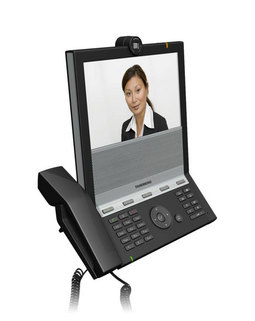In tech, one of the best punch lines around was “the year of videoconferencing.” Since 1990 we heard the year of videoconferencing was coming soon and dozens if not hundreds of video companies have disappeared while waiting to take advantage of this new age of visual communications. I have been meeting with videoconferencing companies for many years and over the last few it has become evident that video is here to stay and it will become a bigger and bigger part of our lives.
The most recent conversation which drove this home was with Tandberg where I spoke with Tony Cook VP Marketing Americas and Rick Snyder President Tandberg Americas. The pair went on to explain how their business is doing well and that market research shows they are taking share of market from others. While spending has slowed in many segments of the market including tech, the communications market has proven more resilient. But it is evident that when you lose more than 1.5 million US jobs per quarter (not to mention elsewhere) for a prolonged period, the need for endpoints decreases.
In the face of this endpoint pressure it is worth pointing out that Polycom recently saw its telepresence services grow 45% in the most recent quarter. The reason of course has to do with travel budgets being slashed and the need to communicate more effectively over distance.
Tandberg credits the quality level of their solutions as the reason for their growth in video market share as well as a focus on interoperability with a variety of solutions. They also happened to mention their acquisition of Codian which brought them a variety of high quality solutions such as an HD multipoint bridge. I discussed the company back in June of 2007.

Another point the execs made was that in the last few recessions video just wasn’t where it is today. They went on to point out their 1700 MXP personal telepresence solution (pictured) costs around $10 thousand and can be paid for with the savings of two international trips. I was told a typical ROI for the company’s customers is 6-9 months with one seeing a savings of 11 million euros over three years.
But for Tandberg, typical enterprise videoconferencing is only one of the solutions they provide as they offer cameras which integrate with a company’s supply chain to allow more efficient and in many cases real-time problem solving. Other clients use the Tandberg solutions to monitor oil rigs. Yet other companies utilize their solutions to save money while becoming more carbon neutral.
The key Tandberg catchphrase from the meeting was definitely, “We call this the new way of working. This will replace a lot of other means of communications.”
The company as you might expect uses its own solutions and they tell me once you get used to using video it is difficult to go back to audio – video allows you to sense people’s passion they explain. It is tough to get the true story without it they say. In addition, more tangible benefits include acceleration of the decision-making process; the ability to bring together globally distributed work teams, the scaling of knowledge, work life balance improvements and an increase in productivity while lowering costs.
Another concept the pair discussed was the ability to perform training sessions over video which can be recorded and used in the future to train others. In this case your video solution basically becomes a training DVR.
Another topic of discussion was their HD video desk phone the E20 (pictured) which is a sleek device with an impressive 10.6″ screen, resolution of up to 1280×780 and a $1,500 list price tag. They see this phone as a conduit allowing them into more applications and vertical markets such as healthcare, government, education, etc. While I have to say the E20 is one of the nicest videophones I have seen if not the nicest, one has to wonder if we aren’t at a point where netbooks can be turned into desk phones. Why not? Isn’t a high-powered videophone more or less a laptop with a few functions added and a bunch of functions removed?
Although our conversation didn’t mention it explicitly, it seems that the year of video has come and gone without the mention from the press I thought it would receive. Then again in retrospect which year was it? 2008? It might have happened so slowly that we didn’t notice but the trend is in place and more and more calls are going to utilize video and while doing so, increase productivity and provide a better user experience while reducing carbon emissions. Am I am the first to notice? Probably not. But I am still happy to be sharing the good news.
Other than solving a breath quality issue, I am not sure what the benefits of the videoconference in this Tandberg supplied photo are. 




Lorna Lyle
April 20, 2009 at 9:47 amAccording to today’s Washington Post:
Veterans Affairs has canceled or delayed 26 conferences, opting for less costly alternatives such as video conferencing, saving nearly $17.8 million.
So maybe President Obama’s administration will help put video conferencing in the forefront of news – and top of mind with event and budget planners.
jan-martin51
July 9, 2010 at 8:07 amMost discussions of video conferencing ignore the public video conference hire market. This sector is also growing at 40% a year, and it allows companies to use professional video conferencing facilities on an occasional basis. There are a number of service providers, I’ve used these http://www.eyenetwork.us.com
Related Articles
Vonage Elevates Cloud Communications with Advanced Noise Cancellation and AI Integration
How LeapXpert Combines Consumer Messaging with Enterprise Security and Compliance
GTT Communications: Pioneering the Future of Managed Network and Security Services